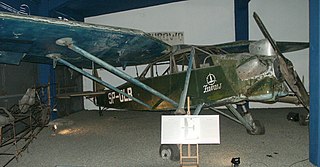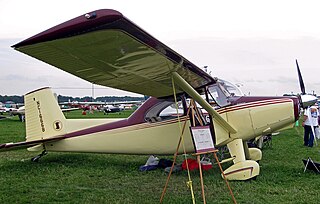
The Piper PA-15 Vagabond and PA-17 Vagabond are both two-seat, high-wing, conventional gear light aircraft that were designed for personal use and for flight training and built by Piper Aircraft starting in 1948.

The Stinson 108 is a popular single-engine, four-seat, light general aviation aircraft produced by the Stinson division of the American airplane company Consolidated Vultee, from immediately after World War II to 1950. The 108 was developed from the prewar Model 10A Voyager.

The RyanNavion is a single-engine, unpressurized, retractable gear, four-seat aircraft originally designed and built by North American Aviation in the 1940s. It was later built by Ryan Aeronautical Company and the Tubular Steel Corporation (TUSCO).
The Aeronca Model 9 Arrow was a low-wing all-metal cabin monoplane with retractable landing gear. It was marketed to returning pilots from World War II and unveiled in 1947 but never went into production.

The Culver Cadet is an American two-seat light monoplane aircraft, also as a radio-controlled drone, produced by the Culver Aircraft Company.

The Temco T-35 Buckaroo was designed in the late 1940s as an extremely low-cost trainer for commercial and military markets. Temco's failure to secure a United States Air Force order for the Buckaroo forced it to turn to non-U.S. governments to keep the production lines going, yet only a few export orders materialized.

The Camair Twin Navion was a civil utility aircraft produced in the United States in the 1950s by converting single-engine Ryan Navions to twin-engine power. It had been one of two programs to improve the performance of the otherwise-pleasing Navion that was generally considered to be underpowered. The other program had resulted in the TEMCO-Riley D-16A Twin Navion. The Twin Navion design had been undertaken by the White brothers of White Engineering in San Antonio, Texas. They replaced the Navion's engine with a baggage compartment, mounted two engines within new nacelles attached to the wing leading edges, fitted the aircraft with a new tail fin made of fiberglass, and added tip tanks made from recycled WWII napalm canisters. Designated the WE-1, the prototype and the rights were sold to Camair soon after its first flight in 1953 and Civil Aviation Authority type certification was achieved in May 1955 under the name Camair 480. Sales were slow and Camair built only 25 examples before selling off the rights in 1959. The ownership of these rights would change hands twice again over the following decade but only another eight aircraft would be built after the end of Camair's involvement

The Elliotts of Newbury EoN or Elliotts EoN A.P.4 was a 1940s British four-seat touring monoplane aircraft built by Elliotts of Newbury.

The Funk Model B was a 1930s American two-seat cabin monoplane designed by Howard and Joe Funk. Originally built by the Akron Aircraft Company later renamed Funk Aircraft Company.

The Harlow PJC-2 was a 1930s American four-seat cabin monoplane, designed by Max Harlow.
The Piper PA-6 Sky Sedan was a 1940s American four-seat light aircraft designed and built in prototype form by Piper Aircraft at its Lock Haven, Pennsylvania, factory.

The Piper PT-1 was a 1940s American two-seat primary training monoplane designed and built by Piper Aircraft at Lock Haven. A low-wing tandem two-seat monoplane, the PT-1 was the first Piper aircraft to have a low-wing. It had a fabric covering over an all-metal fuselage frame and wooden spar wings and tail unit. The PT-1 had a retractable tailwheel landing gear and was powered by a 130 hp (97 kW) Franklin 6AC-2980D engine. No further aircraft were built. A four-seat development was designed as the Piper PWA-6 which did not go into production either.

The Schweizer SGS 1-23 is a United States Open and Standard Class, single-seat, mid-wing glider built by Schweizer Aircraft of Elmira, New York.

The LWD Żuraw was a Polish utility and liaison aircraft prototype of 1951, a high-wing monoplane with single engine, that did not enter production. The name means crane.

The Luscombe 11 Sedan is a civil utility aircraft produced in the United States in the late 1940s.

The Meyers MAC-125 is a light sport aircraft developed in the United States in 1947, produced in a small series as the MAC-145.
The THK-5 was a twin-engine aircraft designed by Stanisław Rogalski and built in Turkey in 1945 as an air ambulance. It was a conventional, low-wing cantilever monoplane of wooden construction throughout. The main units of the tailwheel undercarriage retracted into the wing-mounted engine nacelles and the THK-5 could carry two stretcher cases plus a medical attendant. This was followed in production by a six-seat utility transport version designated THK-5A and three examples of an improved version of the 5A designated THK-10. A single example of the type was exported, sold to Denmark.

The Johnson Rocket 185 was a 1940s American two seat cabin monoplane designed by Johnson and built at Fort Worth, Texas.

The Temco D-16 is a 1950s twin engine civil aircraft from the United States. It was produced by conversion of a Ryan Navion to replace its single engine with two wing-mounted engines. It is commonly known as the Twin Navion, although that name is also often applied to a later similar conversion, the Camair 480.

The CSS-12 was a prototype Polish twin-engined feederliner of the 1950s. A single example was built and flown in 1950, but no production followed.



















